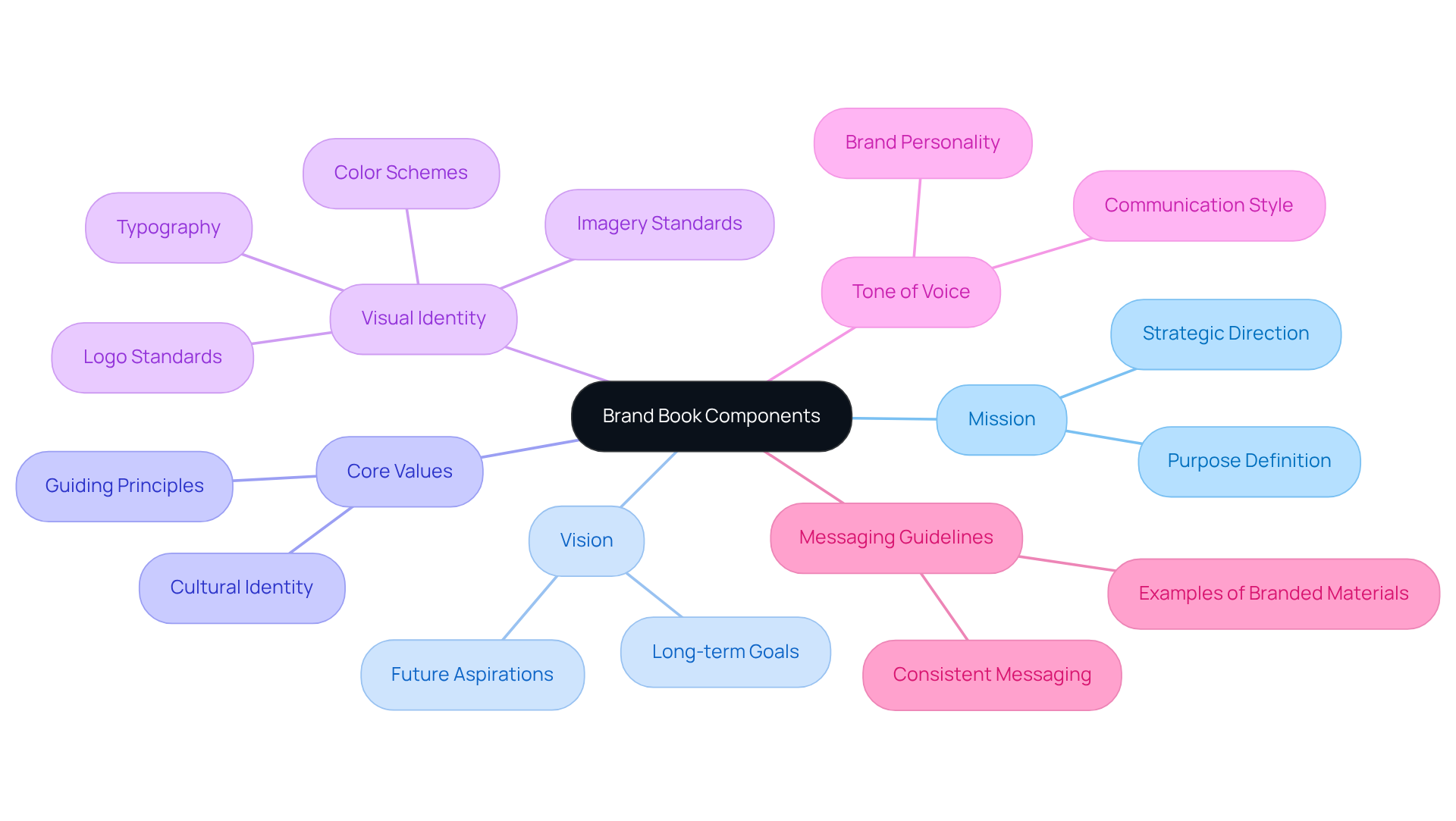Overview
Brand books play a crucial role in the success of tech startups. They serve as a comprehensive guide that articulates a company's identity, ensuring consistency in branding and communication. Many founders face the challenge of establishing a strong brand presence in a competitive landscape, and this inconsistency can lead to confusion and missed opportunities. The implications of not having a well-defined brand can be significant, affecting everything from customer trust to revenue generation.
However, the good news is that a well-crafted brand book can lead to substantial benefits. It fosters increased revenue, enhances customer trust, and streamlines onboarding processes. These elements are critical for navigating the competitive tech landscape. By embracing the power of a brand book, founders can create a supportive foundation for their startup's journey, ensuring that every aspect of their branding resonates with their core values and mission.
Introduction
Navigating the tech industry can often feel like wandering through a labyrinth, particularly for startups eager to carve out their unique space in a saturated market. It’s a daunting challenge, and many founders may find themselves questioning how to effectively establish their identity. Here, a well-defined brand book emerges as a vital companion on this journey. It serves not just as a guide for visual and verbal communication but also as a strategic asset that can profoundly influence a company’s trajectory.
Yet, the question lingers: is investing in a brand book truly worth the effort and resources? In this article, we will explore the essential role that brand books play in the success of tech startups, delving into their benefits, key components, and the lasting impact they can have on fostering a sustainable brand identity. Together, let's uncover how this resource can help you navigate your path with confidence and clarity.
Define the Brand Book: Purpose and Importance
A style guide is more than just a document; it embodies a company's identity, weaving together its mission, vision, values, and visual elements. It serves as a compass for maintaining consistency across all marketing efforts, ensuring that every piece of communication resonates with the organization’s core principles. For many new businesses, the significance of a cannot be overstated; it is a vital resource that helps articulate their , allowing them to shine in a crowded marketplace. Defining the essence of a company offers clarity and direction, which is especially crucial for tech startups navigating their industry's complexities.
At RNO1, we understand that a is essential for . We are dedicated to through Return On Design & Digital (RODD) strategies, ensuring that every facet of an identity is thoughtfully considered. Take, for example, our partnership with the EOS Network Foundation. Together, we have transformed their , fostering innovation within the EOS Network. Similarly, our collaboration with Amount has evolved their , culminating in an impressive $100M funding milestone.
These strategic partnerships and illustrate our commitment to fostering digital growth and innovation in marketing. We empower contemporary entities to create across platforms, ensuring that they feel supported every step of the way. We invite you to join us on this journey, sharing your experiences and aspirations as we work together to navigate the exciting landscape of technology and design.
Explore the Benefits: Why Startups Should Invest in a Brand Book
For tech startups, investing in a is crucial, as it offers a wealth of benefits that can significantly impact their success. Many founders struggle with establishing a , which is vital for building trust with both customers and stakeholders. Imagine the relief of knowing that research indicates 68% of businesses experience a 10-20% simply by maintaining consistency in their branding. This highlights the direct link between a style guide and financial success. A well-defined guide ensures that every marketing material—from your website to social media posts—echoes a unified voice and visual style, essential for .
Moreover, a style guide makes the onboarding process smoother for new team members and external partners, providing them with a clear understanding of your identity and guidelines. In the fast-paced world of startups, this clarity is especially important for achieving alignment and operational efficiency. Additionally, a style guide can by effectively communicating your company’s vision and strategic direction, which is vital for securing funding and support.
Ultimately, consider a style guide as a books journey. It not only ensures consistency and clarity but also helps . Did you know that 81% of consumers are more likely to remember a company by its color than its name? This underscores the importance of in shaping consumer perceptions. In conclusion, a style guide is more than just a document; it is a strategic resource that empowers technology companies to navigate their branding effectively and foster lasting connections with their audience.

Outline Essential Components: What to Include in Your Brand Book
Creating a thorough identity manual can feel overwhelming for tech startups, yet it’s essential for guiding their brand books and . Many founders struggle with defining their organization's , which are crucial in establishing a clear purpose and strategic direction. Without these elements, it can be challenging to convey what your company stands for.
plays a significant role in this journey. A well-crafted style guide that outlines logos, color schemes, typography, and imagery standards helps ensure a unified aesthetic. Research shows that by up to 80%. This highlights how important visual elements are in marketing and how they can impact your startup's success.
Moreover, it’s vital to outline the to maintain consistent communication across various platforms. Think about how confusing it can be for potential customers when they encounter mixed messages. Including examples of branded materials can clarify how to apply these guidelines in practice, making it easier for you to stay on track.
Statistics reveal that across all platforms can . Companies that present a uniform image are three to four times more likely to achieve increased visibility. This underscores the importance of . By weaving these crucial elements together, you can create strong brand books that serve as invaluable resources for all your branding efforts. Remember, you’re not alone in this; many founders have faced similar challenges, and with the right support, you can navigate this path successfully.

Assess the Long-Term Impact: Building a Sustainable Brand Identity
The long-term effect of a meticulously crafted is truly significant for tech ventures. Many startup founders grapple with the challenge of establishing a . This challenge can often feel overwhelming, especially when fostering —essential elements for sustainable growth. A consistent company presence not only enhances recognition but also nurtures emotional ties with consumers, leading to repeat business and referrals. As your venture develops, remember that the identity guide can serve as a flexible document, adjusting to market fluctuations or shifts in company focus, ensuring that your identity remains pertinent and aligned with your core principles.
Investing in a style guide is not just a decision; it is a in your startup's future, laying the foundation for enduring success. Statistics indicate that companies with of up to 23%, underscoring the . Additionally, expert insights reveal that a clearly articulated corporate image can significantly boost customer trust, resulting in improved retention rates and greater .
Consider the experiences of others—case studies illustrate how . These partnerships highlight how robust company personas enhance customer loyalty and foster engagement through innovative strategies. In essence, brand books are not just guides; they are vital tools for that resonates with customers and supports long-term success. We invite you to share your experiences and explore how RNO1 can help you navigate this journey together.
![]()
Conclusion
For tech startups, navigating the complexities of establishing a strong brand can feel overwhelming. The challenge lies not just in defining a brand's visual and verbal elements but in ensuring consistency across all platforms. This consistency is vital for building trust and recognition in a competitive marketplace. A brand book emerges as a beacon of guidance, articulating a startup's mission, vision, and values, and serving as a roadmap for marketing efforts that foster a cohesive brand presence.
As we reflect on the various benefits of investing in a brand book, it becomes clear that the impact extends far beyond aesthetics. Startups often struggle with onboarding processes and investor confidence, yet a well-defined style guide can enhance these areas significantly. The insights reveal that a unified brand presence correlates directly with financial success, highlighting the necessity for startups to prioritize brand consistency as they strive to thrive in their industries.
Ultimately, the importance of a brand book is profound; it represents a strategic investment in a startup's future. By committing to a comprehensive branding guide, tech startups can not only navigate market complexities but also cultivate sustainable relationships with their audience. As the technology landscape continues to evolve, embracing effective branding principles will support immediate goals while paving the way for long-term success. We encourage startups to prioritize the development of their brand books, leveraging them as powerful tools for growth and innovation. Together, we can foster a community where every startup thrives.
Frequently Asked Questions
What is the purpose of a brand book?
A brand book serves as a style guide that embodies a company's identity, weaving together its mission, vision, values, and visual elements. It ensures consistency across all marketing efforts and helps articulate the unique value proposition of a business.
Why is a branding guide important for new businesses?
For new businesses, a branding guide is vital as it provides clarity and direction, helping them stand out in a crowded marketplace. It articulates their unique value proposition and maintains consistency in communication.
How does RNO1 approach brand identity and design?
RNO1 emphasizes a design-oriented approach to crafting meaningful experiences, focusing on maximizing marketability through Return On Design & Digital (RODD) strategies. This ensures that every aspect of a brand's identity is thoughtfully considered.
Can you provide examples of RNO1's client partnerships?
RNO1 has partnered with the EOS Network Foundation to transform their digital identity and customer experience, and with Amount to evolve their digital experience design, which led to an impressive $100M funding milestone.
What is the overall goal of RNO1 in their partnerships?
RNO1 aims to foster digital growth and innovation in marketing, empowering contemporary entities to create transformative digital experiences across platforms while providing support throughout the process.




